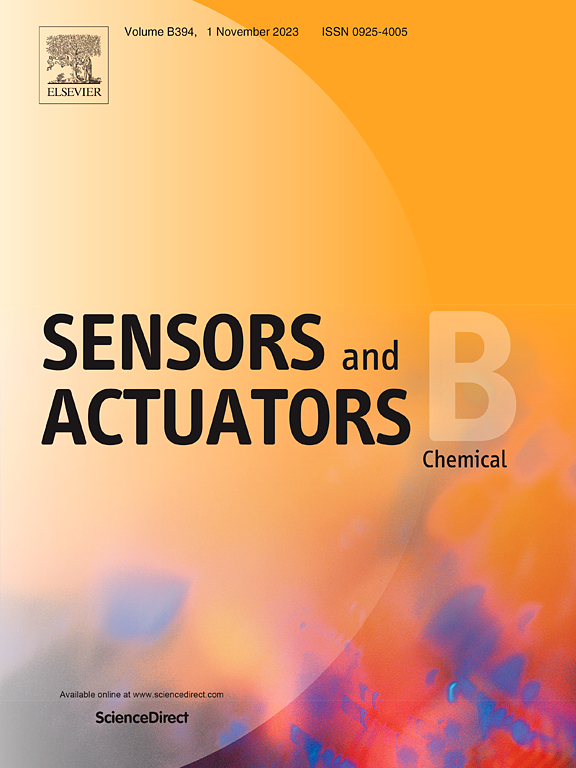肽功能化光纤生物传感器耦合系数驱动快速傅里叶变换优化SARS-CoV-2刺突蛋白检测
IF 3.7
1区 化学
Q1 CHEMISTRY, ANALYTICAL
引用次数: 0
摘要
在这项工作中,我们提出了一种新型光纤传感器,用于检测SARS-CoV-2刺突蛋白的受体结合域(RBD)。该传感器利用精确控制法布里-帕姆罗腔内的光,其中外壁由两种来自ACE2蛋白的肽化学功能化,这两种肽对刺突蛋白具有高亲和力。我们的方法集中于监测耦合系数的变化,它直接影响耦合回光纤芯的反射光束的功率。这些变化是通过使用傅里叶变换技术分析反射光的干涉模式来检测的。传感器的灵敏度通过其检测耦合系数随刺突蛋白浓度增加的微小变化的能力得到证明,当所有肽一起使用时,检测限低至0.018 ng/mL。该传感器具有出色的灵敏度、选择性和重复性,FFT强度与蛋白质浓度之间具有很强的线性相关性(R²= 0.99)。这种创新的生物传感器设计具有显著的优势,包括实时分析、高灵敏度和小型化潜力,使其成为快速准确检测SARS-CoV-2和其他含有RBD区域的病毒病原体的有前途的工具。此外,尽管我们的方法已经对刺突蛋白进行了实验评估,但通过重新设计功能化肽以靶向新的生物标志物,生物传感器可以很容易地适用于其他病原体的检测,从而为解决当前和未来病毒检测中的挑战提供了一个多功能平台。本文章由计算机程序翻译,如有差异,请以英文原文为准。
Optimized SARS-CoV-2 spike protein detection via coupling coefficient-driven fast fourier transform analysis in a peptide-functionalized fiber optic biosensor
In this work, we present a novel fiber optic-based biosensor designed for the detection of the Receptor Binding Domain (RBD) of the SARS-CoV-2 spike protein. The sensor leverages the precise control of light within a Fabry-Pérot cavity, where the external wall is chemically functionalized with two peptides derived from the ACE2 protein that exhibit a high affinity for the spike protein. Our approach is centered on monitoring variations in the coupling coefficient, which directly affects the power of the reflected light beam coupled back into the fiber core. These variations are detected by analyzing the interference patterns of the reflected light using Fourier Transform techniques. The sensitivity of the sensor is demonstrated through its ability to detect minute changes in the coupling coefficient as the concentration of the spike protein increases, with detection limits as low as 0.018 ng/mL when all peptides are used together. The sensor exhibits exceptional sensitivity, selectivity, and repeatability, with a strong linear correlation (R² = 0.99) between the FFT intensity and the protein concentration. This innovative biosensor design offers significant advantages, including real-time analysis, high sensitivity, and the potential for miniaturization, making it a promising tool for the rapid and accurate detection of SARS-CoV-2 and other viral pathogens containing the RBD region. Moreover, although our approach has been experimentally evaluated for the spike protein, the biosensor could be readily adapted for the detection of other pathogens by redesigning the functionalized peptides to target new biomarkers, thereby providing a versatile platform for addressing current and future challenges in viral detection.
求助全文
通过发布文献求助,成功后即可免费获取论文全文。
去求助
来源期刊

Sensors and Actuators B: Chemical
工程技术-电化学
CiteScore
14.60
自引率
11.90%
发文量
1776
审稿时长
3.2 months
期刊介绍:
Sensors & Actuators, B: Chemical is an international journal focused on the research and development of chemical transducers. It covers chemical sensors and biosensors, chemical actuators, and analytical microsystems. The journal is interdisciplinary, aiming to publish original works showcasing substantial advancements beyond the current state of the art in these fields, with practical applicability to solving meaningful analytical problems. Review articles are accepted by invitation from an Editor of the journal.
 求助内容:
求助内容: 应助结果提醒方式:
应助结果提醒方式:


